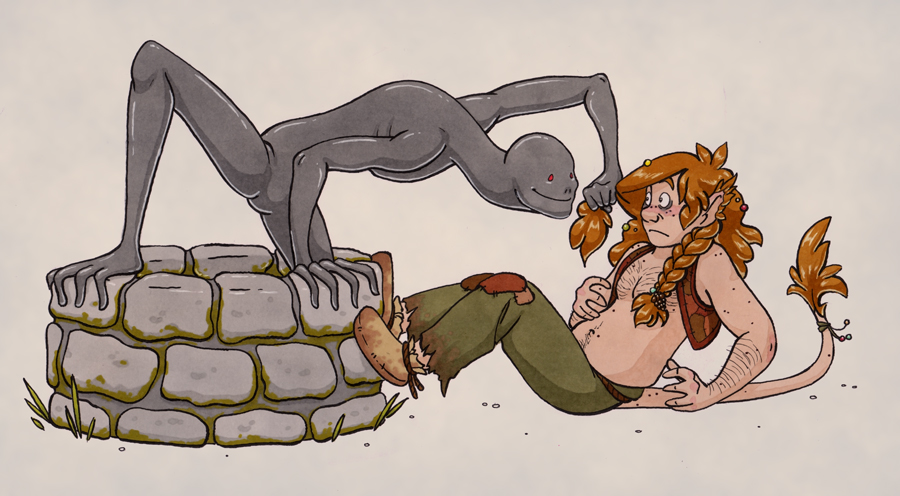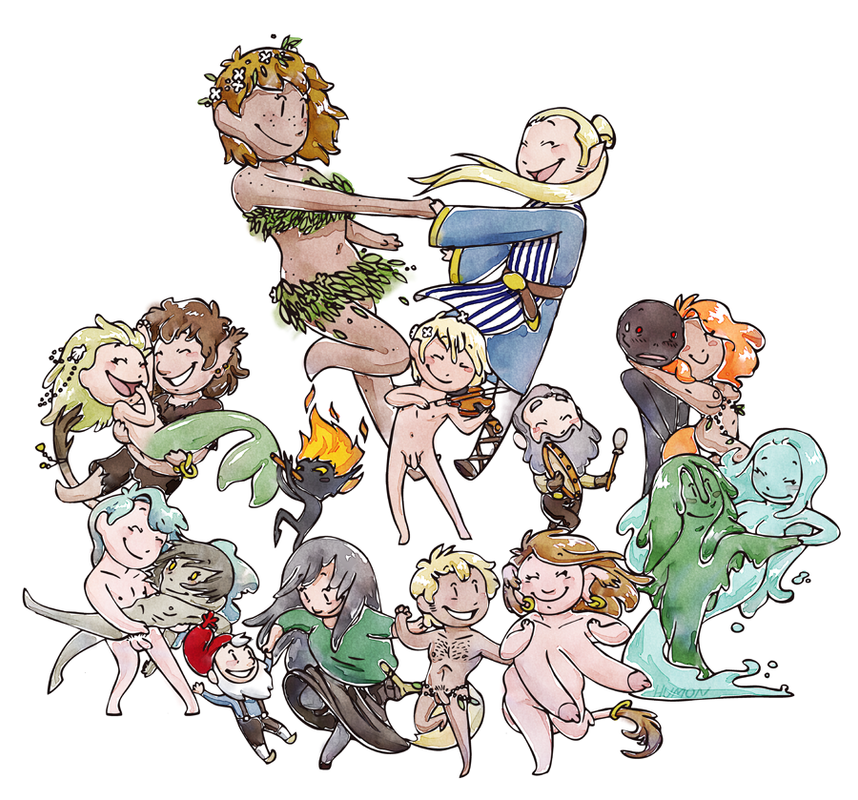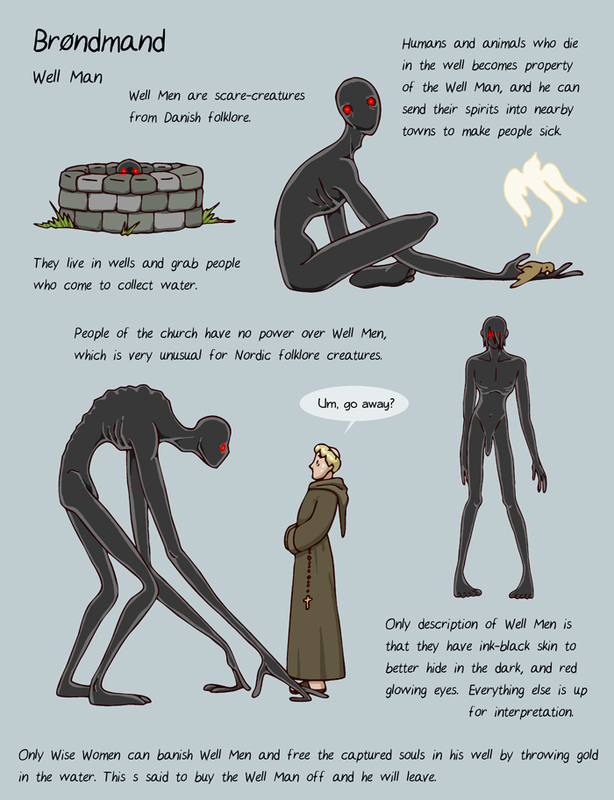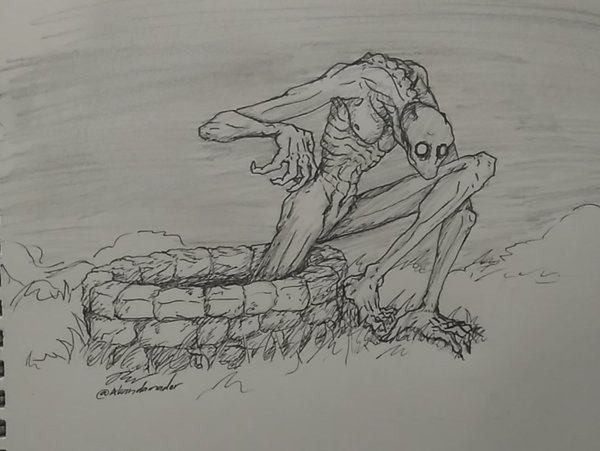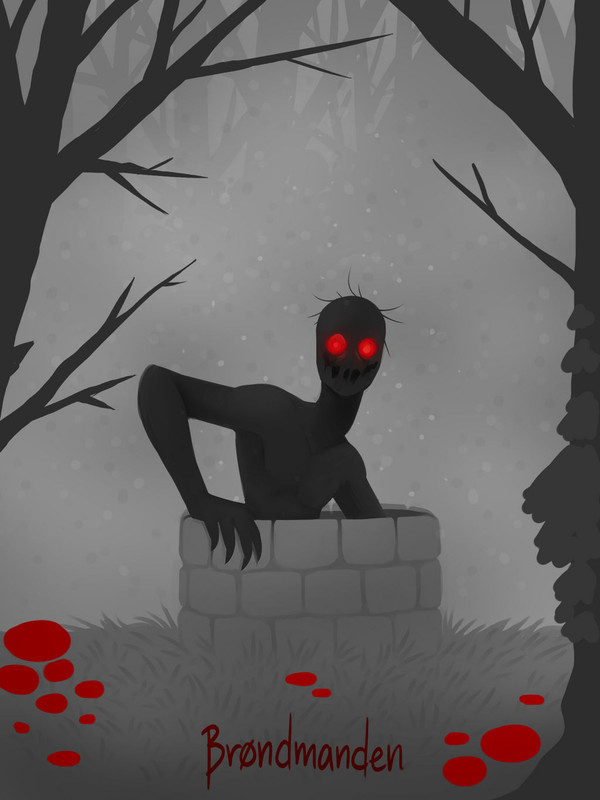
Etymology
"Well Man" is a direct translation of the Danish name "brøndmand." It is a relatively recent name for this figure, possibly originating in the 1800s or 1900s. Every other known name is exclusively used to refer to the bogeyman-version of this creature, including den sorte mand (the black man), brøndtrolden (the well troll), brøndtossen (the well fool), and manden i brønden (the man in the well).¹ Prior to his recorded use as a bogeyman, the Well Man does not appear to have had a common name.
Other recent names include krogmanden (the crook man), brøndkællingen (the well crone), kildemanden (the wellspring man), hølmanden (the hole man), Grønne Anders (Green Anders), Røde Anders (Red Anders), fodhals (foot-neck), and bukkelars (buck/billygoat-guy).²

As a creature
I have so far only found one story of the Well Man as an actual creature adults believed in, retold by Holbek & Piø based on a record in Helsingør Record Book the 6th of August 1582: "Söffren Arkeliemester developed a cramp in his leg so severe that he could find no peace; and that is when Kirstine Brender came by to read the arthritis off his leg. And when they finally allowed this, she asked for 3 schilling coins, went down to Söffren's well, threw a rock in the well, and said the following words: Hear ye words in the well, here you have oats for your horses, bread for your dogs."¹
Do keep in mind that I have not been able to track down the 1582 book in which this was first recorded, and that I have had to take some liberties with my English translation, so this what you're reading is essentially a 4th-hand source.
According to Holbek & Piø, folklorist Ferdinand Ohrt interprets this anecdote as follows: The wise woman believes that Söffrens sickness is caused by the Well Man's livestock, which haunt Söffren in the form of disease demons. To take back his livestock and leave Söffren alone, the Well Man must be paid a settlement. Similar stories are found in France, where apples are sometimes thrown in the well to cleanse the water, and in "Czechoslovakia," where bread is thrown in the well on holidays in exchange for plentiful water.¹

As a bogeyman
Bogeymen related to wells have presumably existed everywhere in Denmark. It's one of the most predictable figures for parents to create, on par with "the ghost in the boiler room" or "the monster in the attic" – and I can personally recall, from my own childhood, the undeniable feeling that something dangerous lurked within our well, before I even read about the Well Man, and without my mom telling scary stories. That wells are dangerous is a simple fact.
Scary stories that can be categorized as being about the "Well Man," have primarily been recorded in Jutland, as far as I've been able to see – though most commonly under the name "crook man" (spelled "e krochmann" in the synnejysk [South Jutish] dialect). In Jysk Ordbog [Jutish Dictionary] he is a described as a bogeyman which adults would "scare children with to keep them away from wells or to keep them from the deep end of the lake," and there are two examples of use: "The Crook Man sits down in the well; he has a long crook, with which he pulls down kids if they are not careful" (1988) and "Crook Man... He was out in the water and he had a long staff with a hook at the end, which he grabbed kids with if they went too far out in the water. We were told this when we were kids" (1976).⁴

Today
Belief in the Well Man seems rare today – even as a bogeyman, its last solidly documented occurrence seems to have been in the middle of the 1900s.² That doesn't mean it has been completely forgotten, though. The artist Humon, for example, has repeatedly drawn the Well Man, along with other Danish folkloric creatures, and has thus spread knowledge of him outside the borders of Denmark.
Further, the Well Man has been incorporated as a monster in the roleplaying game "Vaesen – Nordic Horror Roleplaying," separated into the three types 'brøndmand,' 'brøndkælling' and 'brøndtrold,' all of which share the same appearance (a twisted reflection of the person looking into the well) and are described as "a scary story which has gained a life of its own."
The three types are differentiated by their behavior. Brøndmanden is characterized by appearing in a well when enough parents have told their children to watch out for him – he lives off of children's fear, and will use his long crook to drown a child once in a while to keep the fear alive. Brøndkællingen has immense knowledge of diseases and cures, which she whispers to those who stick their heads into the well – her hope is that they will fall in and drown. Brøndtrolden moves into a well with the goal of pulling down passers-by with its long arms and drowning them.³

Gallery

Sources
1. "Fabeldyr og Sagnfolk," page 99 (1967). Bengt Holbek & Iørn Piø. Politikens Forlag.
2. "Det farlige vand – om krogmanden og andre skræmmevæsener på Facebook og i dialektordbøger" (2018). Asgerd Gudiksen & Malene Monka. dialekt.dk.
3. "Brøndtrold, Brøndmand, Brøndkælling" (2021). Morten Greis. Fria Ligan AB.
4. "Jyske Ordbog," Krogmand (2022). Peter Skautrup Centret. Institut for Kommunikation og Kultur, Aarhus Universitet.
5. "E Krochman" (201▯). Asta Flyvholm Kjær.
1. "Fabeldyr og Sagnfolk," page 99 (1967). Bengt Holbek & Iørn Piø. Politikens Forlag.
2. "Det farlige vand – om krogmanden og andre skræmmevæsener på Facebook og i dialektordbøger" (2018). Asgerd Gudiksen & Malene Monka. dialekt.dk.
3. "Brøndtrold, Brøndmand, Brøndkælling" (2021). Morten Greis. Fria Ligan AB.
4. "Jyske Ordbog," Krogmand (2022). Peter Skautrup Centret. Institut for Kommunikation og Kultur, Aarhus Universitet.
5. "E Krochman" (201▯). Asta Flyvholm Kjær.
